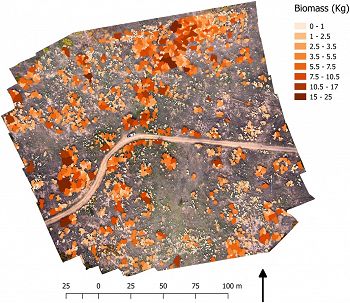Krofcheck et al., 2019
Allometric relationships for Quercus gambelii and Robinia neomexicana for biomass estimation following disturbance
Krofcheck D.J., Litvak M.E., Hurteau M.D. (2019)
Ecosphere 10(10): e02905
Abstract
Mapped shrub biomass across a field site in the Las Conchas fire footprint in the Jemez Mountains, New Mexico. Here the biomass estimates were calculated using the volume‐driven combined species allometry, where only objects >0.3 and <5 m were considered in the analysis.
In the southwestern USA, increases in size, frequency, and severity of wildfire are driving the conversion of forests to shrub‐dominated ecosystems. Increases in drought extent and severity, coupled with the way that shrub‐dominated systems are perpetuated by high‐severity fire, predisposes these post‐disturbance landscapes to remain in a non‐forest condition. Consequently, understanding the distribution of aboveground biomass in post‐disturbance, shrub‐dominated ecosystems is central to constraining the uncertainty surrounding how these ecosystems interact with light and water to sequester carbon. Here we present allometric regressions for Quercus gambelii (Gambel oak) and Robinia neomexicana (New Mexico locust), two species that dominate post‐fire landscapes in the southwestern USA. Our allometric regressions are designed to be driven by either field plot or high‐resolution remote sensing data, using either shrub area or shrub volume to estimate biomass.
Citation
Krofcheck D.J., Litvak M.E., Hurteau M.D. (2019): Allometric relationships for Quercus gambelii and Robinia neomexicana for biomass estimation following disturbance. Ecosphere 10(10): e02905. DOI: 10.1002/ecs2.2905
 This Paper/Book acknowledges NSF CZO grant support.
This Paper/Book acknowledges NSF CZO grant support.
Explore Further

